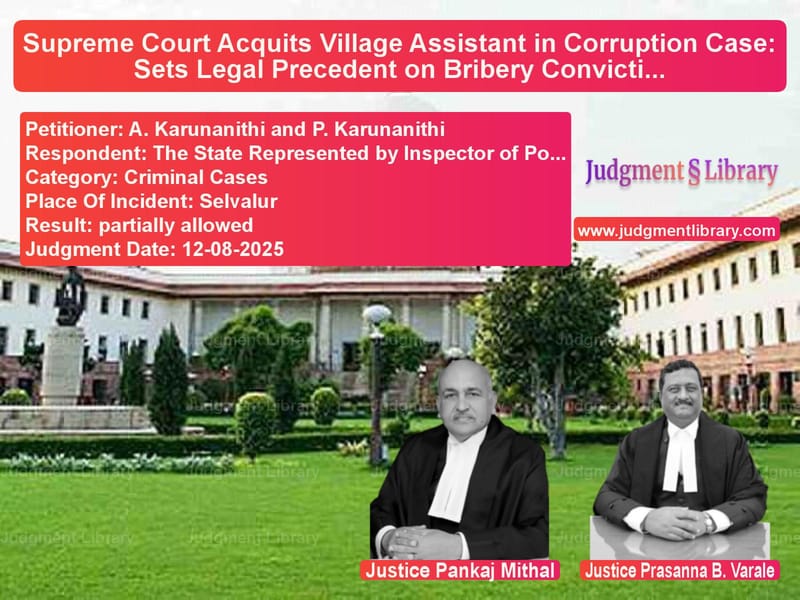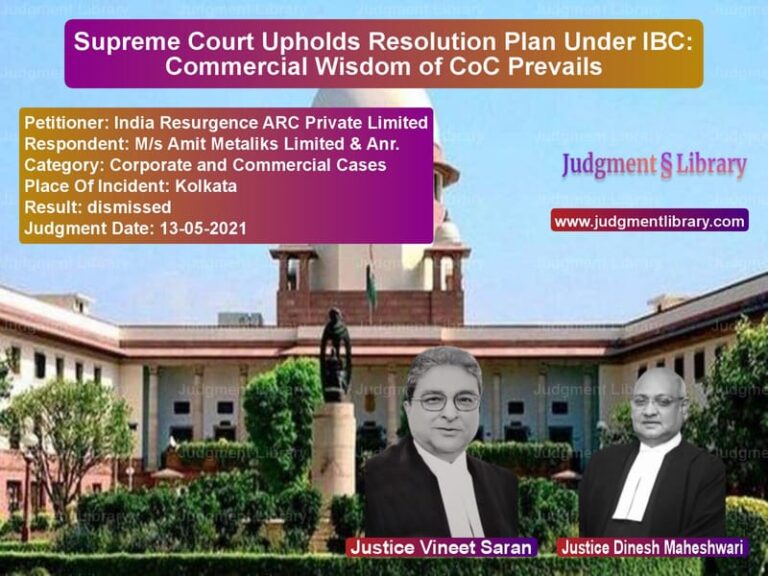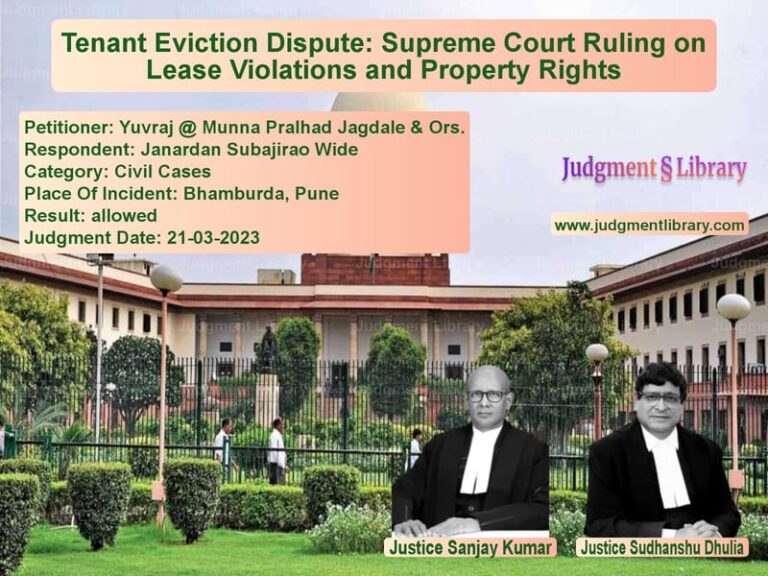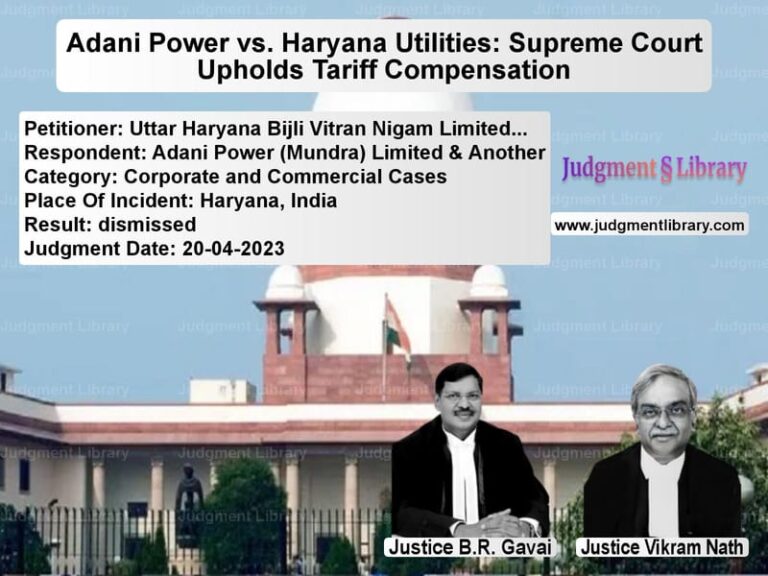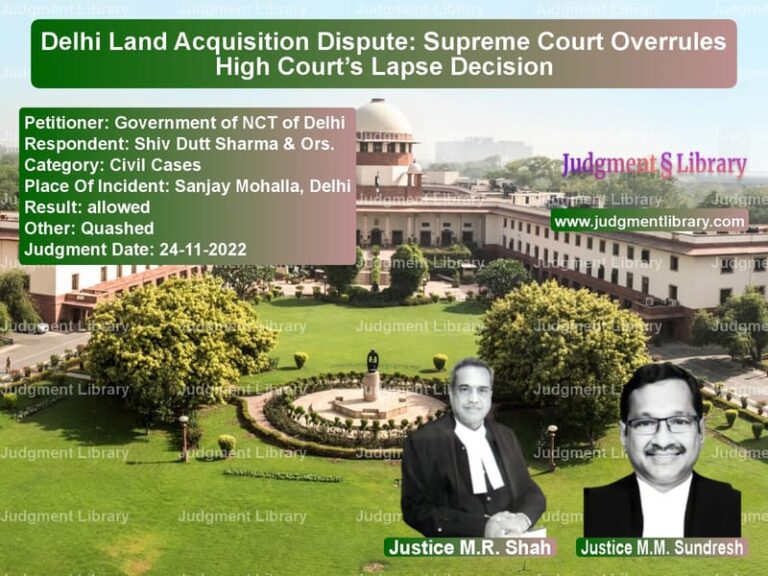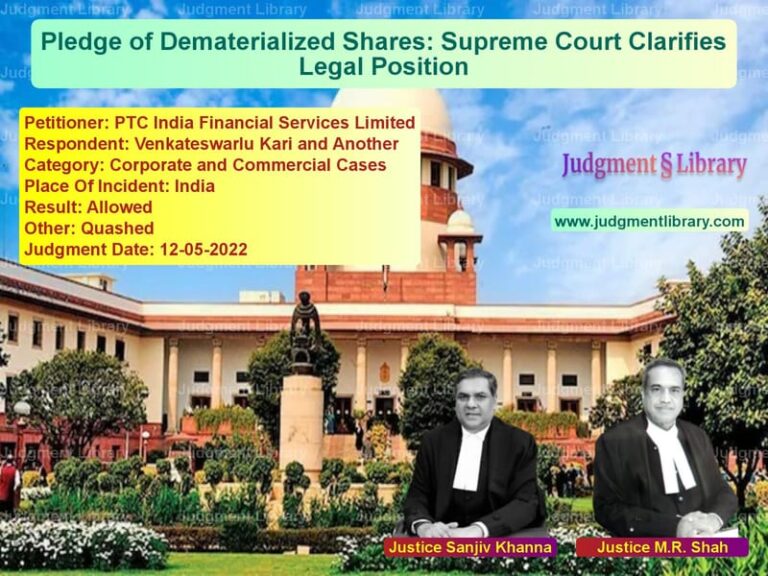Supreme Court Acquits Village Assistant in Corruption Case: Sets Legal Precedent on Bribery Conviction Requirements
In a significant judgment that clarifies the legal requirements for convicting public officials in corruption cases, the Supreme Court of India recently delivered a nuanced verdict that acquitted a junior government employee while upholding the conviction of his senior officer. The case, which involved a bribe of merely Rs. 500 for issuing a community certificate, highlights the critical distinction between demanding illegal gratification and merely following orders in government hierarchy, setting important legal precedents for future corruption cases.
The legal battle began in 2004 when A. Karunanithi, serving as Village Administrative Officer at Selvalur, allegedly demanded a bribe of Rs. 500 from complainant V. Rengasamy for processing his application for a Community Certificate needed for government employment. The complainant approached the authorities, leading to a carefully planned trap by the Vigilance and Anti-Corruption Department on December 3, 2004, where marked currency notes treated with phenolphthalein powder were used as evidence.
The Trap and Trial
During the trap operation, when the complainant approached A. Karunanithi (A-1), the officer reiterated his demand for the bribe but instructed his subordinate, P. Karunanithi (A-2), who worked as a Village Assistant in the same office, to collect the money. The complainant handed the marked currency notes to A-2, who counted them and kept the money as directed by his superior. The trap team then moved in, seized the currency notes, and conducted the phenolphthalein test on A-2’s hands, which turned pink, confirming contact with the treated notes.
Following the successful trap, FIR Crime No. 8 of 2004 was registered under the Prevention of Corruption Act, 1988. After investigation, both accused were charged under Section 7 (public servant taking gratification) and Section 13(1)(d) read with Section 13(2) (criminal misconduct by public servant) of the Act. The Special Court convicted both accused in 2011, sentencing A-1 to three years rigorous imprisonment for the more serious offense and two years for the other, while A-2 received one and a half years and one year respectively. The High Court upheld these convictions in 2018, leading to the current appeals before the Supreme Court.
Legal Arguments Before the Supreme Court
Senior counsel Shri S. Nagamuthu, representing both appellants, presented distinct arguments for each accused. For A-1, he sought sentence reduction rather than challenging the conviction itself. He argued that “the High Court failed to consider that the age of A-1 is 68 years and that he was involved in a case pertaining to a petty amount of Rs.500/- as bribe and that too in the year 2004.” He requested that “keeping in mind the time elapsed and the small amount of the bribe, the sentence imposed upon him is excessive and it could be reduced to the statutory minimum sentence of one year.”
For A-2, however, the counsel mounted a more fundamental challenge to the conviction itself. He contended that “his conviction is illegal in the absence of evidence that there was demand of illegal gratification by him or that he was present when A-1 originally demanded the bribe.” Emphasizing the legal requirements for conviction, he argued that “unless there is demand and receipt of the bribe, he cannot be convicted.”
The counsel further strengthened his argument for A-2 by pointing out that “A-2 cannot be convicted for merely accepting the money as there was no specific charge of abetment or allegation that A-1 was the abettor of the crime.”
The State’s counsel defended the convictions, arguing that the case stood proved against A-1 through the oral evidence of the Revenue Divisional Officer (PW-1) and the complainant (PW-2). The State emphasized that “the Courts have repeatedly emphasised that the punishment under the Act ought to be deterrent in order to maintain public trust and prevent corruption.” Therefore, no leniency should be shown to A-1 by reducing his punishment.
Regarding A-2, the State contended that “offence has also been proved against A-2 as he had accepted the illegal gratification on behalf of the A-1. He had knowingly accepted the money on behalf of A-1. He was aware that it was a bribe money.” The State argued that “he had a fair trial, therefore, the absence of a formal charge of abetment would not vitiate his conviction.”
The Supreme Court’s Legal Analysis
The Supreme Court bench comprising Justices Pankaj Mithal and Prasanna B. Varale began its analysis by referencing the Constitution Bench decision in Neeraj Datta vs State (NCT of Delhi), which had held that “for recording a conviction under Section 7 and Sections 13(1)(d)(i) and (ii) of the Act, the prosecution has to prove the demand and acceptance of illegal gratification either by direct evidence which can be in the nature of oral evidence or documentary evidence or circumstantial evidence.” The court emphasized that “to convict a person under the aforesaid provision demand and acceptance of illegal gratification is a sine qua non.”
Applying this fundamental principle to A-2’s case, the court observed that “It is no one’s case that A-2 ever demanded any illegal gratification. He undoubtedly accepted the money on the directions of A-1 and kept the same with him. So, there was no demand of illegal gratification on his part.” The court further noted that “The demand made by A-1 cannot be attributed to A-2 as no evidence was adduced which could establish that A-2 was a habitual offender working in aid with A-1 or was facilitating A-1 in demanding and receiving illegal gratification.”
The court made a crucial distinction: “Accordingly, in the absence of any allegation or evidence that A-2 demanded bribe from the complainant or he was acting in connivence with A-1, he cannot be prosecuted for the commission of the crime of demanding and receiving illegal gratification.”
The absence of a specific abetment charge proved fatal to the prosecution’s case against A-2. The court noted that “Admittedly, A-2 was not charged with the abetment of the aforesaid crime. He had accepted the money on the direction of A-1 only. He could have received the money innocently on the direction of A-1 or he may have received it knowingly. Both the views are possible.” However, since “no evidence was adduced to prove that both of them have connived to demand and accept the bribe, even if a fair trial may have been given to the A-2, it cannot be said with any certainty that he was an accomplice to the crime.”
Precedent and Legal Principles
The Supreme Court reinforced its reasoning by citing Mahendra Singh Chotelal Bhargad vs. State of Maharashtra & Ors., where it had dealt with a similar situation where “the bribe was demanded by one person and was accepted and recovered from a third person.” In that case, “The conviction of the said third person was set aside, holding that accepting money on behalf of another person may certainly constitute an abetment of an offence, but in the absence of a charge of abetment, the person accepting the bribe is not liable to be convicted.”
Based on this precedent, the court concluded that “Accordingly, the Trial Court as well as High Court manifestly erred in convicting him for an offence under Section 7 and 13 of the Act.”
Different Treatment for the Main Accused
While acquitting A-2, the court took a different view regarding A-1, the main accused who had actually demanded the bribe. The court found that “The evidence on record amply proves that he demanded bribe from the complainant not only once but twice, and thereafter when the trap was laid. The bribe on his behalf was accepted by A-2. The evidence proves that A-2 accepted the money on the dictates of A-1. Therefore, both the ingredients of demand and receipt stand duly proved against A-1.”
The court noted that “The evidence in this regard of PW-1 and PW-2, despite some minor contradictions stand unshaken. Therefore, in our opinion, his conviction as held by the Trial Court and affirmed by the High Court is not liable to be interfered with.”
However, the court showed some leniency in sentencing for A-1, considering the specific circumstances. The court acknowledged that “There is no dispute to the fact that the offence was allegedly committed in the year 2004 and it involved a small amount of Rs. 500/-. A-1 had suffered on account of the pendency of the trial and appeal for all these years.” Considering “The long time that has elapsed during the trial and the appeals coupled with the fact that the amount involved is small, it appears just and proper to award the minimum sentence prescribed under the Act.”
The court clarified that “The argument that the Court cannot show compassion to reduce the sentence by exercising powers under Article 142 of the Constitution is misconceived as the Court is not showing leniency by overriding or going beyond the statutory provisions. The reduction of sentence is within the scope of the statute which provides for a minimum sentence of one year.”
The Final Judgment
In its conclusive ruling, the Supreme Court “confirm[ed] the conviction of A-1 but reduce[d] his sentence from three and two years respectively to the minimum of one year for both the offences as prescribed under the Act.” The court modified the High Court’s judgment accordingly and “allow[ed] his appeal in part.”
For A-2, the court delivered a complete acquittal, stating that “The judgment and order of the Trial Court and the High Court insofar they convict A-2 are set aside. His appeal stands allowed.”
Broader Implications
This judgment carries significant implications for anti-corruption jurisprudence in India. First, it reinforces the fundamental legal principle that both demand and acceptance of illegal gratification must be proven for conviction under the Prevention of Corruption Act. Mere acceptance of money, without evidence of demand or prior agreement, may not suffice for conviction unless specifically charged as abetment.
Second, the judgment provides important protection to junior government employees who may be compelled to follow orders from superiors without necessarily being part of corrupt designs. The court recognized the hierarchical reality in government offices where subordinates often have limited choice but to comply with instructions from seniors.
Third, the judgment demonstrates the Supreme Court’s nuanced approach to sentencing, considering factors such as the amount involved, the time elapsed since the offense, and the age of the accused, while still maintaining the deterrent effect of corruption laws.
Finally, the case underscores the importance of precise charging in corruption cases. The prosecution’s failure to frame abetment charges against A-2, despite having evidence of his involvement in the transaction, proved fatal to their case against him.
This balanced approach ensures that while corruption is punished appropriately, legal technicalities and principles are not sacrificed in the pursuit of convictions, maintaining the integrity of the criminal justice system.
Petitioner Name: A. Karunanithi and P. Karunanithi.Respondent Name: The State Represented by Inspector of Police.Judgment By: Justice Pankaj Mithal, Justice Prasanna B. Varale.Place Of Incident: Selvalur.Judgment Date: 12-08-2025.Result: partially allowed.
Don’t miss out on the full details! Download the complete judgment in PDF format below and gain valuable insights instantly!
Download Judgment: a.-karunanithi-and-p-vs-the-state-represente-supreme-court-of-india-judgment-dated-12-08-2025.pdf
Directly Download Judgment: Directly download this Judgment
See all petitions in Fraud and Forgery
See all petitions in Custodial Deaths and Police Misconduct
See all petitions in Extortion and Blackmail
See all petitions in Attempt to Murder Cases
See all petitions in Other Cases
See all petitions in Judgment by Pankaj Mithal
See all petitions in Judgment by Prasanna Bhalachandra Varale
See all petitions in partially allowed
See all petitions in supreme court of India judgments August 2025
See all petitions in 2025 judgments
See all posts in Criminal Cases Category
See all allowed petitions in Criminal Cases Category
See all Dismissed petitions in Criminal Cases Category
See all partially allowed petitions in Criminal Cases Category

